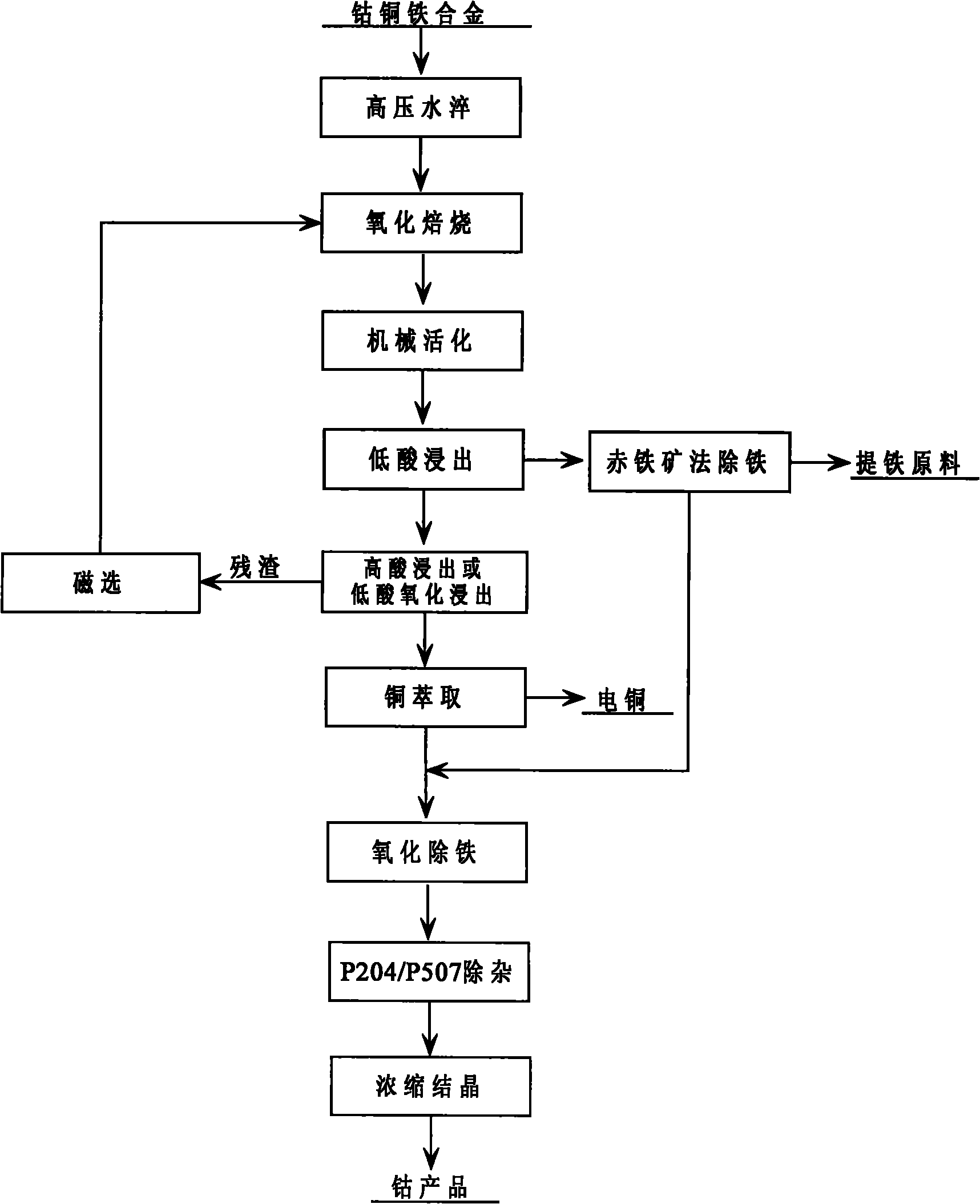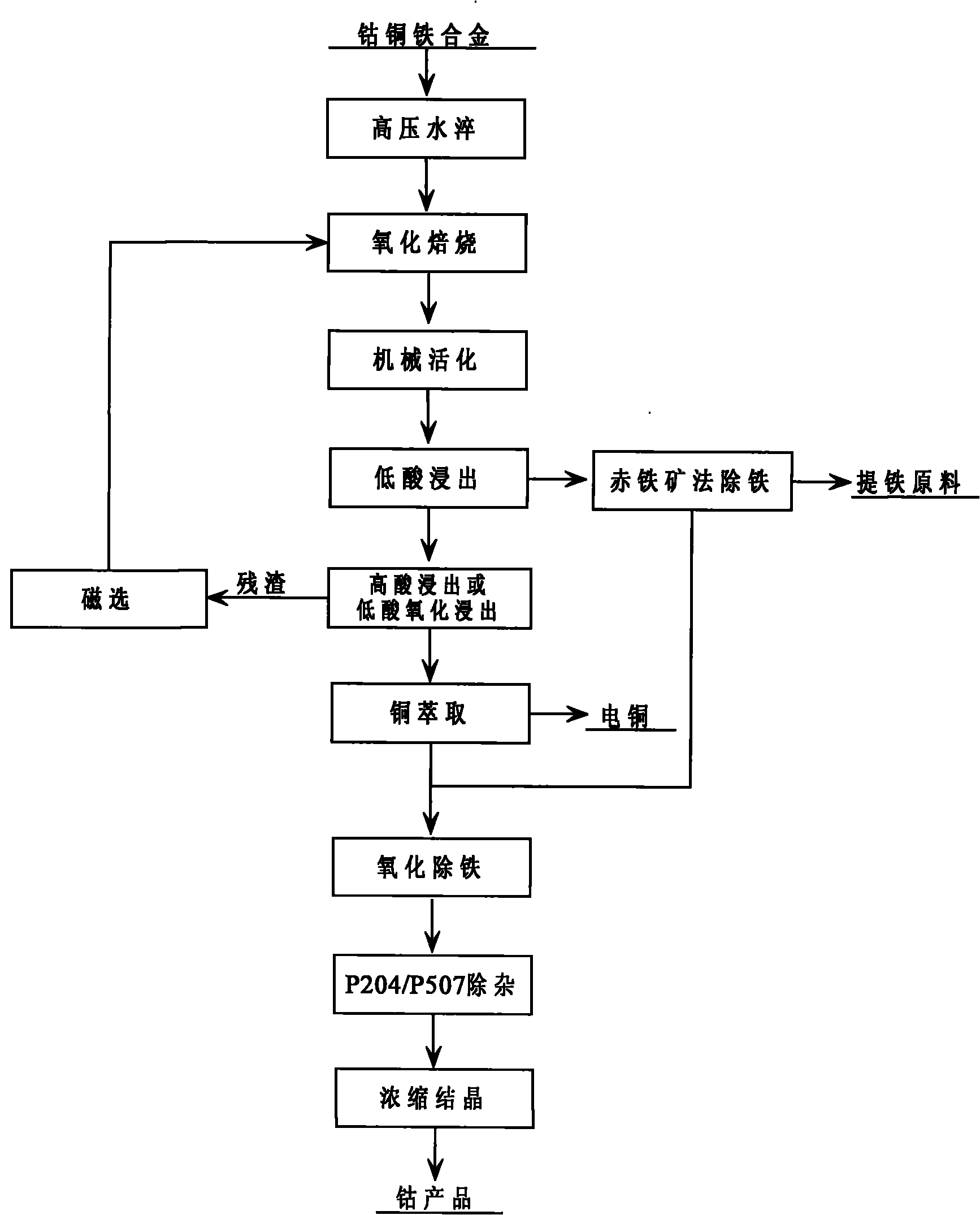Method for processing cobalt-copper-iron alloy
A technology of cobalt-copper-iron alloy and alloy powder, which is applied in the field of processing cobalt-copper-iron alloy, can solve the problems of long process flow and complex equipment, and achieve the effects of simple process flow, short processing time and low investment cost
- Summary
- Abstract
- Description
- Claims
- Application Information
AI Technical Summary
Problems solved by technology
Method used
Image
Examples
Embodiment 1
[0022] Take 100 kg of cobalt-copper-iron alloy, quench it into 150-mesh alloy powder by high-temperature and high-pressure water, then put the alloy powder into a rotary kiln for oxidation and roasting at 1200°C for 10 hours, and then put the roasted alloy material into a vibration mill Mechanical activation was carried out for 80 minutes to obtain alloy powder with an average particle size of 100 microns. Get 100g of alloy powder after mechanical activation, control the solid-liquid ratio to be 1: 10, control the pH value at 3.0 during the reaction, stir and react at 50°C for 8 hours, filter and wash, analyze the cobalt-copper-iron content in the filtrate and slag. The one-stage leaching rate of cobalt is 90.11%, the one-stage leaching rate of iron is 100%, and the copper is basically not leached. Then 20 g of the leaching residue was directly dissolved with 5 mol / L sulfuric acid, the solid-liquid ratio was controlled to be 1:6, and the reaction was stirred and reacted at 100...
Embodiment 2
[0024] Take 100 kg of cobalt-copper-iron alloy, quench it into 30-mesh alloy powder by high-temperature and high-pressure water, then put the alloy powder into the rotary kiln for oxidative roasting at 500°C for 6 hours, and then put the roasted alloy material into the vibration mill Mechanical activation was carried out for 20 minutes to obtain alloy powder with an average particle size of 200 microns. Get 100g of alloy powder after mechanical activation, control the solid-liquid ratio to be 1:5, control the pH value at 1.5 during the reaction, stir and react at 100°C for 10 hours, filter and wash, analyze the cobalt, copper and iron content in the filtrate and slag. The one-stage leaching rate of cobalt was 87.31%, the one-stage leaching rate of iron was 99.65%, and copper was basically not leached. Then 21.16g of the leaching residue is controlled to a solid-liquid ratio of 1:5, directly dissolved with 1mol / L sulfuric acid, stirred and reacted at 50°C for 10 hours, and the ...
Embodiment 3
[0026] Take 100 kg of cobalt-copper-iron alloy, quench it into 80-mesh alloy powder by high-temperature and high-pressure water, then put the alloy powder into the rotary kiln for oxidative roasting at a temperature above 600°C for 6 hours, and then put the roasted alloy material into the vibration mill The machine was mechanically activated for 20 minutes to obtain alloy powder with an average particle size of 10 microns. Get 100g of alloy powder after mechanical activation, control the solid-liquid ratio to be 1: 10, control the pH value at 0.5 during the reaction, stir and react at 70°C for 2 hours, filter and wash, analyze the cobalt, copper and iron content in the filtrate and slag. The one-stage leaching rate of cobalt was 84.96%, the one-stage leaching rate of iron was 99.24%, and copper was basically not leached. Then use 5g of sodium chlorate as an oxidant for 22g of the leaching residue, control the solid-liquid ratio to 1:8, add sulfuric acid dropwise to keep the pH...
PUM
| Property | Measurement | Unit |
|---|---|---|
| particle size | aaaaa | aaaaa |
| particle size | aaaaa | aaaaa |
Abstract
Description
Claims
Application Information
 Login to View More
Login to View More - Generate Ideas
- Intellectual Property
- Life Sciences
- Materials
- Tech Scout
- Unparalleled Data Quality
- Higher Quality Content
- 60% Fewer Hallucinations
Browse by: Latest US Patents, China's latest patents, Technical Efficacy Thesaurus, Application Domain, Technology Topic, Popular Technical Reports.
© 2025 PatSnap. All rights reserved.Legal|Privacy policy|Modern Slavery Act Transparency Statement|Sitemap|About US| Contact US: help@patsnap.com


